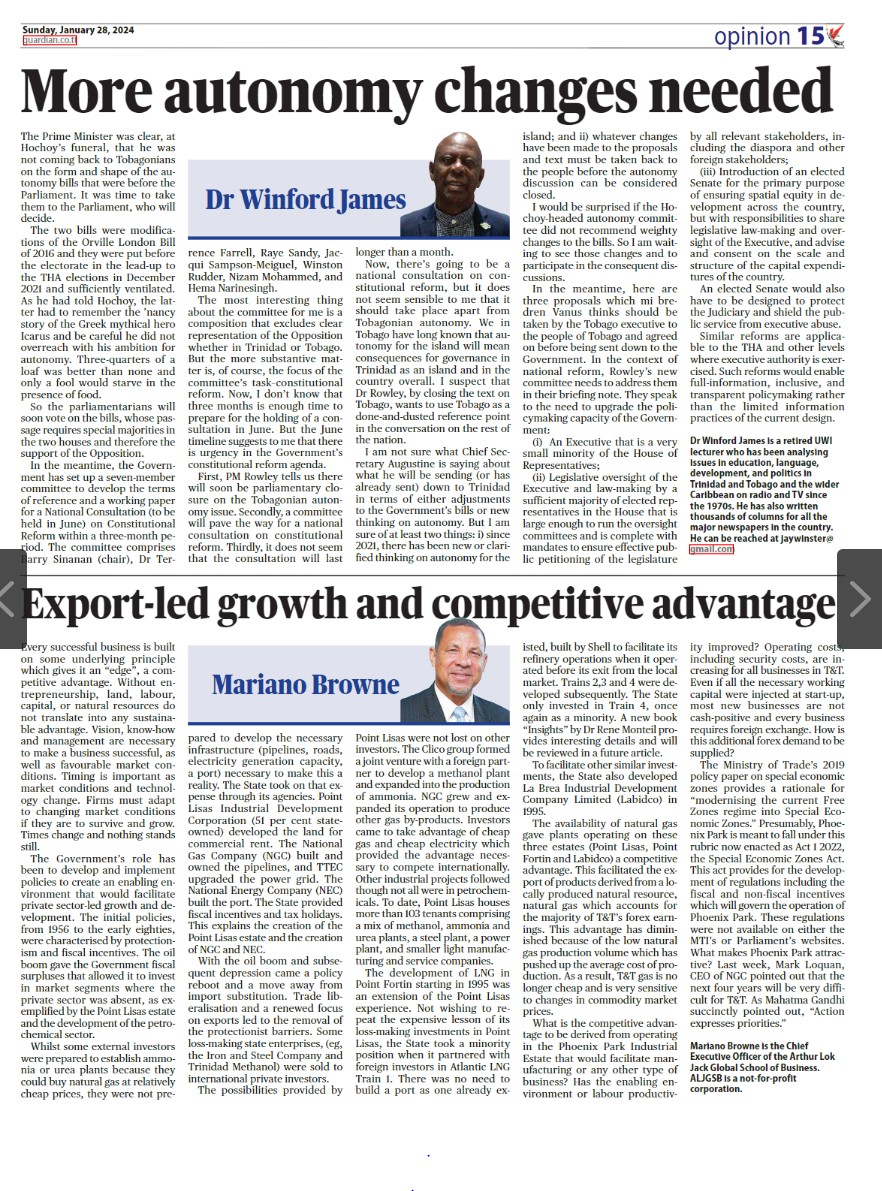Export led growth and competitive advantage
Mariano Brovvne Ilia rry successful business Is built on some underlying principle which gives it WI "edge", a competitive advantage. Without entrepreneurship, land. labour. capital, or natural resources do not translate into any sustainable advantage. Vision, knowhow and management are necessary to make a business successful, as well as favourable market conditions. Timing is important as market conditions and technology change. Firms must adapt to changing market conditions if they are to survive and grow. Times change and nothing stands still. The Government's role has been to develop and implement policies to create an enabling environment that would facilitate private sectorled growth and development. The initial policies. from 1956 to the early eighties. were characterised by protectionism and fiscal incentives. The oil boom pave the Government fiscal surpluses that allowed it to invest in market segments where the private sector was absent, as exemplified by the Point Lisas estate and the development of the petrochemical sector. Whilst some external investors were prepared to establish ammonia or urea plants because they could buy nantral gas at relatively cheap prices, they were not prepared to develop the necessary infrastructure (pipelines, roads, electricity generation capacity. a port) necessary to make this a reality. The State took on that expense through its agencies. Point Lisas Industrial Development Corporation (51 per cent stateowned) developed the land for commercial rent. The National Gas Company (NCO built and owned the pipelines, and TTEC upgraded the power grid. The National Energy Company (NEC) built the port. The State provided fiscal incentives and tax holidays. This explains the creation of the Point Lisas estate and the creation of ?ICC and NEC. With the oil boom and subsequent depression came a policy reboot and a move away from import substitution. Trade liberalisation and a renewed focus on exports led to the removal of the protectionist barriers. Some lossmaking state enterprises, kg, the Iron and Steel Company and Trinidad Methanol) were sold to international private investors. The possibilities provided by Point I.isas were not lost on other investors. The Clico group formed a joint venture with a foreign partner to develop a methanol plant and expanded into the production of ammonia. NGC grew and expanded its operation to produce other gas byproducts. Investors came to take advantage of cheap gas and cheap electricity which provided the advantage necessary to compete Internationally. Other industrial projects followed though not all were in petrochemicals. To date. Point Lisas houses more than 103 tenants comprising a mix of methanol, ammonia and urea plants, a steel plant, a power plant, and smaller light manufacturing and service companies. The development of LNG in Point Fortin starting In 1995 was an extension of the Point Usas experience. Not wishing to repeat the expensive lesson of its lossmaking investments in Point Lisas. the State took a minority position when it partnered with foreign investors in Atlantic LNG Train I. There was no need to build a port as one already existed. built by Shell to facilitate its refinery operations when it operated before its exit from the local market. Trains 2,3 and 4 were developed subsequently. The State only invested in Train 4, once again as a minority. A new book "Insights" by Dr Rene Monteil provides interesting details and will be reviewed in a future article. To facilitate other similar investments. the State also developed La Brea Industrial Development Company Limited (Labidco) in 1995. The availability of natural gas gave plants operating on these three estates (Point lams, Point Fortin and labidco) a competitive advantage. This facilitated the export of productsderhed from a lo tally produced natural resource. natural gas which accounts for the majority of T&T's fora earnings. This advantage has diminished because of the low natural gas production volume which has pushed up the average cost of production. As a result, T&T gas is no longer cheap and is very sensitive to changes in commodity market prices. What Is the competitive advantage to be derived from operating in the Phoenix Park Industrial Estate that would facilitate manufacturing or any other type of business? has the enabling environment or labour productivity improved? Operating cos including security costs, are increasing for all businesses in T&T. Even if all the necessary working capital were injected at startup, most new businesses are not cashpositive and every business requires foreign exchange. flow is this additional Cores demand to be supplied? The Ministry of Trade's 2019 policy paper on special economic zones provides a rationale for "modernising the current Free Zones regime into Special Economic Zones." Presumably, Phoenix Park is meant to fall under this rubric now enacted as Act 1 2022, the Special Economic Zones Act. This act provides for the development of regulations including the fiscal and nonfiscal Incentives which will govern the operation of Phoenix Park. These regulations were not available on either the MTN or Parliament's websites. What makes Phoenix Park attractive? Last week, Mark Loquan, CEO of NGC pointed out that the next four years will be very difficult for WE As Mahatma Gandhi succinctly pointed out. "Action expresses priorities' tin Mariano Browne K the Chief Executive Officer of the Arthur Lok Jack Global School of Business. AUGSB is a notforprofit corporation.

